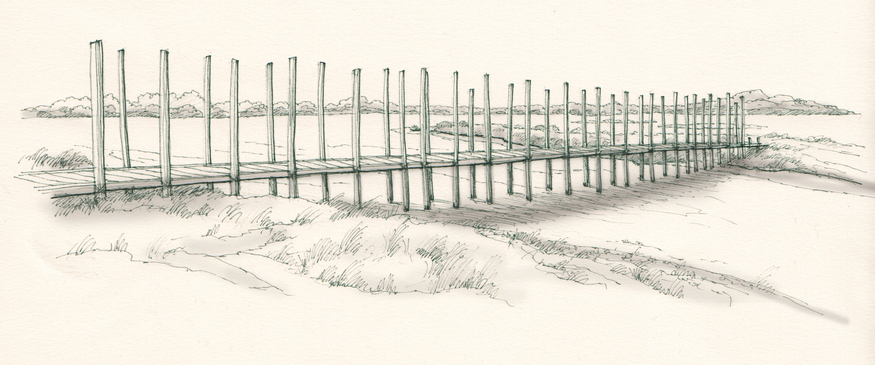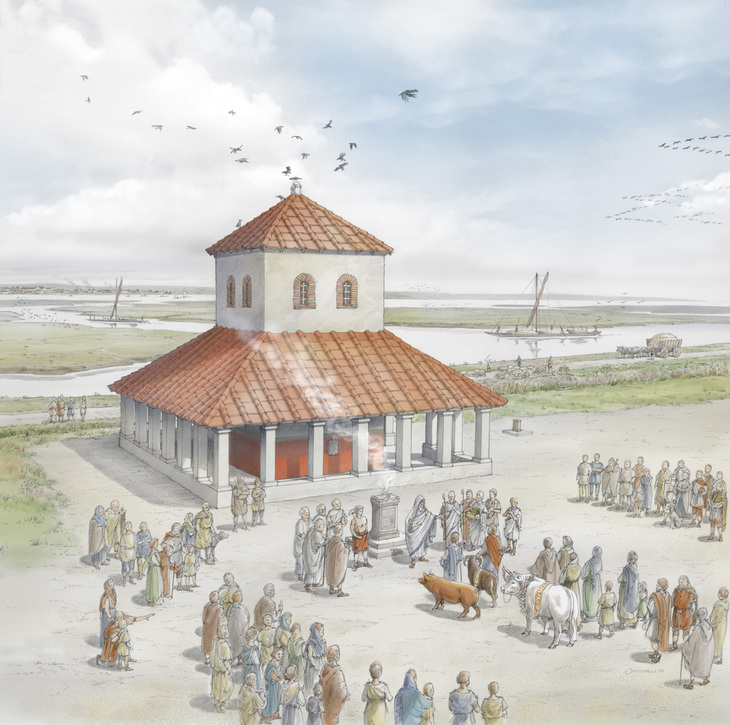Londonist
19 Images That Tell The Vivid History Of The South Bank
For more of all things London history, sign up for our new (free) newsletter and community: Londonist: Time Machine .
London's South Bank: The History is a sweeping and ambitious story of the famous neighbourhood on the Thames, by Mireille Galinou. Here, the author selects 19 images from her book, which together paint a vivid timeline of one of London's most storied neighbourhood.
Prehistory: Reconstruction of the Vauxhall jetty or bridge dating from around 1500 BC, based on the remnants of a four-metre-wide structure discovered in 1993. © Stephen Conlin
Roman: Artist's reconstruction of one of the two temples which stood near St George's Church in Southwark in the 2nd century. By Chris Mitchell for Douglas Kinnock et al's 'Temples and Suburbs – Excavations at Tabard Square', PCA, 2015
16th/17th century: Artist's reconstruction of Southwark & Bermondsey around 1600; by that date Bermondsey Abbey had been partially demolished, hence its ghostly appearance bottom right. © Stephen Conlin
16th/17th century: When they refurbished the Garden Museum in 2018, workers discovered a hoard of around 30 lead coffins containing the remains of archbishops and other high-ranking officials. Photo: Craig Dick, Garden Museum
18th century: This beautiful reconstruction of the South Bank, based on several 18th century maps, shows the arrival of two new bridges – Westminster and Blackfriars – which opened up the South Bank to further development. © Stephen Conlin
18th century: The Rotunda at the late Sir Ashton Lever's museum, 3 Great Surrey Street near Blackfriars Bridge, around 1790. The collections narrowly missed being acquired by the British Museum and were sold at auction in 1806. © London Metropolitan Archives (City of London)
18th/19th century: This anonymous watercolour confronts the viewer with the impressive size of the timber trade on the riverbank at Waterloo; the location is clearly identified thanks to the square shot tower. © London Metropolitan Archives (City of London)
Early 19th century: This unusual oil painting, undated and anonymous, is set on the Thames outside Lambeth Palace, by a cluster of mooring posts for barges and lighters. It depicts a barge with tarpaulin over a temporary roof structure to protect from the rain. Yale Center for British Art
Early 19th century: One of the four sections of the magnificent Rhinebeck Panorama – a snapshot in watercolour of the port of London around 1810. The first crossing is the Old London Bridge, shorn of its houses, and to its left, by the water, Southwark's shot tower next to St Olave's Tooley Street, with the future Southwark Cathedral opposite; further along St Thomas' Hospital and church. © Museum of London
Early 19th century: The Dining Hall of the Female Orphan Asylum in Westminster Bridge Road. The agitated little girl in yellow is accompanied by her parents who are no doubt supporters of the asylum. She contrasts with the sober attire and 'good order' of the orphan girls. From Ackermann's 'Microcosm of London' by Pugin & Rowlandson, 1808-1810
Early 19th century: This 1804 watercolour by William Capon shows rural Waterloo prior to its development in the 1820s and 30s. Public pleasure gardens had thrived in the 18th century and this fitted the image of a rural idyll, in great contrast with the next image. © London Metropolitan Archives (City of London)
19th century: The utter transformation of Waterloo, Lambeth, from an airy, green suburb (previous image) to stretches of dark urban terraced houses for the working classes could not be more starkly visualised. The Roupell estate still exists and drew the attention of a contemporary painter, Jonathan Pike, who painted this in 1983. © Guildhall Art Gallery, City of London
Middle 19th century: The Falcon Glassworks in Holland Street, Blackfriars, around 1840. This is the earliest known detailed painting of the interior of a London glasshouse. © Museum of London
Middle 19th century: The second outbreak of cholera in Victorian London (1848-49) was mapped and it brings home the extraordinary difference between north and south bank, the south inordinately affected by the Asiatic pandemic. Wellcome Collection
19th century: The Great Tooley Street fire of 1861 started at Cotton's Wharf and lasted two weeks, destroying all the warehouses alongside the Thames between Chamberlain's Wharf and Hay's Wharf Dock. Contemporary descriptions labelled it 'the largest conflagration since 1666'. © London Metropolitan Archives (City of London)
Late 19th century: This attractive hall formed part of the much-praised Red and White Cross Cottages built in Southwark by the great housing reformer Octavia Hill. Its decoration, which in real life remained unfinished, was on the theme of "heroic deeds of the poor' which would inspire the later creation of the Postman's Park monument in the City. Cottages, gardens and hall have survived, but not the decoration of the hall. From 'The Builder Magazine', 9 November 1889
20th century: Bird's eye view of the 1951 Festival of Britain by John Dean Monroe Harvey. The Festival Hall on the left is a lone survivor. The other famous landmarks were the Dome of Discovery and the Skylon (by Power and Moya architects). The National Archives (UK), ref. WORK25/64/25
21st century: This engraving by John Bryce, 'Thames Arachnid' is dominated by the threatening sculpture of 'Maman' by Louise Bourgeois; it was commissioned by Tate Modern for its millennium opening and later entered the museum's collections (2008). It was exhibited both inside the Turbine Hall and on the gallery's Thames terrace. © John Bryce, 2009
21st century: This 2013 photograph, 'Misty Millennium Bridge', was taken by John Chase, a photographer who, alongside creating his personal portfolio, has worked for many years at the Museum of London. © John Chase
London's South Bank: The History by Mireille Galinou, published by Your London Publishing























